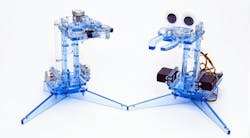While walking around at Maker Faire a few years ago, I met Brett Pipitone, the CEO of Robomotive Laboratories LLC. He had an interesting technology whereby a robotic arm would mimic the movement of a controller operated by a person. This design went a step further by offering what Brett is calling Posi-feel. This is feedback to the controller so the person picking up an object with the remote robotic arm can feel the resistance the object is having on the gripper. This means you can indirectly feel when you’ve made contact with an object, or if it’s ridged or squishy.
Recently, the Cincinnati-based Pipitone started a Kickstarter campaign to launch “mimicArm,” your own programmable robot arm. This is a new STEM program where kids could manipulate a robot arm by a wireless and learn how to program.
While the motors to this design are purposely wimpy to make it safe for kids, I was very interested in the application this could have for gaming with feedback to virtual objects, or for remote technology for HAZMAT or other industrial uses.
Without any feedback it can be difficult to pick up objects. The mimicEducationalRobots (a division of Robomotive Laboratories LLC) offers the feedback needed to feel that you have something in your hand. This makes it easier to accomplish tasks, and for young students to literally gets hands-on with robotics. The idea is to get kids interested in robotics to where they want to be able to tinker with the arm, and hopefully, start to learn how to program it.
“The kids actually program the robot with both the block coding and the Arduino library,” says Pipitone. “The functions simply take care of the more detailed interface tasks. For example readPot() returns the value of the inputBox potentiometer. The kids don’t need to know it’s sending 0xD4 over the I2C bus and performing a checksum on the return.
“Once the user advances to a certain point, they can start using optional function parameters to get things like status codes and to change internal parameters,” he continues. “That’s the big benefit of my robots: They grow with the user’s ability.”
It sounds awesome, and I hope to learn more about this as it develops, but for now, the Kickstarter will go up around April 24th. Check it out here.
The Build
While mimicArm incorporates state-of-the art technology, manufacturing the robot is kept deliberately simple. Except for their circuit boards, mimicArm robots are built entirely with affordable entry level laser cutters and 3d printers. “We’re a small company with unpredictable production levels,” says Brett. “Using modern CNC equipment allows us to minimize capital investments, revise and implement designs quickly, and leverage a near infinite manufacturing base.”
The mimicArm structure is primarily laser-cut cast acrylic, with some load-bearing parts made from ABS. Accent pieces are made from 3D-printed ABS. While acrylic is not common in robots intended for kids, Pipitone says it’s an underutilized resource. “The material looks great and is inviting to students in a way that other robots aren’t. The mechanical design of the robot can minimize the problems associated with the brittleness of the material, and the benefits of scalable manufacturing far exceed the materials limitations for a business or our size.”
One interesting thing caught my attention. For an electronics guy, Pipitone was well aware of GD&T. “We had to design for the material, but we also had to consider the machines we’re using,” he explains. “Entry-level machines don’t hold tolerance or consistent beam width the way higher-priced machines do. We take pains to design our robots to be tolerance-insensitive whenever possible.”
As a mechanical engineer who doesn’t know how to program, I wonder if this could help my understanding of coding. Either way, we need to engage kids with STEM education at a young age, as the demand for STEM skills is only widening and scientific literacy in general is in high demand.
For more information, click here.


